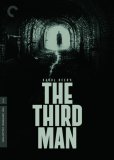| Reviews & Columns |
|
Reviews DVD TV on DVD Blu-ray 4K UHD International DVDs In Theaters Reviews by Studio Video Games Features Collector Series DVDs Easter Egg Database Interviews DVD Talk Radio Feature Articles Columns Anime Talk DVD Savant Horror DVDs The M.O.D. Squad Art House HD Talk Silent DVD
|
DVD Talk Forum |
|
|
| Resources |
|
DVD Price Search Customer Service #'s RCE Info Links |
|
Columns
|
|
|
Third Man - Criterion Collection, The
THE MOVIE:
"It's not that I enjoy puddling in the mess, but if there's a mess, I feel that it's our duty to look at it." - Graham Greene, writer of The Third Man
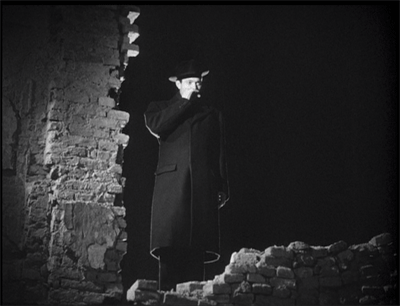
There's a wonderful symmetry to Carol Reed and Graham Greene's classic of British noir, The Third Man. In something akin to the interplay of light and shadow that so epitomizes the movie's visual style, there is also an interplay of various elements in the story itself. Perception and reality, reputation and action, and the solid, old fashioned morality of good and bad. Survivors in this story stand in the gray, neither too enveloped by shadow or too exposed by the light. Forcing the world to conform to an either/or scenario will only be your downfall.
The Third Man is the story of Holly Martins (Joseph Cotten), a pulp novelist who has traveled to post-War Vienna on the request of his school chum, Harry Lime (Orson Welles). Believing he is coming to the bombed-out city to help with a medical charity, Holly is surprised to discover that Harry has died in what the police are calling an accident. Other versions of the story suggest it's murder. The loud and brash American wants Calloway (Trevor Howard), the more reserved British officer who had been investigating Harry, to look into the incident, but in Austria--a territory now divided by several different nations and thus criss-crossed by various standards of laws and lawlessness--such deaths will all come out in the wash. According to his police file, Harry Lime wasn't a very nice dude, and the city's populace is better off without him. Holly refuses to accept that Harry isn't the stand-up guy he always knew--even though even he admits that Harry was always running some kind of racket--and starts poking his nose where it doesn't belong. He's consistently warned away, but his cowboy naivete shoves him hopelessly forward. It's Graham Greene's self-reflexive critique--the writer is going to have to learn the difference between the easy morals of the printed page vs. the complications of the real world.
The title refers to a mysterious figure who was there at Harry's death but whom no one will officially identify. Holly believes the key to finding the truth is uncovering the identity of the third man. In another nice piece of symmetry, Holly picks up a female sidekick along the way. Anna (Alida Valli) is a Czech actress who was Harry's lover, and she's the only person besides Holly who will ever swear to Harry doing a bit of good. Together, they will have their belief in the man they knew tested, and Holly will also become smitten with her. Does he really love her, though, or is it a kind of playground payback for another indiscretion years prior? (Anna even calls him Harry a couple of times.) Or, once again, must it really be one or the other? All we really know is that only Anna's cat is truly loyal to the missing figure. He doesn't trust Holly, but he still has a thing for Harry.
The Third Man has earned a reputation based on three major components. First, the dark visual style. Reed plays up the noirish paranoia by taking full advantage of shadows, showing men in silhouette or their figures cast across a stone wall. The climactic chase through the Austrian sewers is dizzying and exciting, taking us down into the metaphorical underground of men's souls via the foreboding tunnels pumping their real world waste. The second component is the zither music, and the famous Harry Lime theme that would become an international hit.
The third, not coincidentally, is Harry Lime himself. As played by Orson Welles, he is an attractive scoundrel. When he shrugs and asks his pal what the big deal is, it's hard not to chime in, "Yeah, Holly, what's the big deal?" His entrance in the movie is often cited as one of the most famous in cinema. Where first there was darkness, then there is light, and with it, Welles' impeccable naughty-boy smirk. The amazing thing is that Welles is barely in the movie, only a couple of scenes. Oftentimes, when a movie is about how everyone is obsessed with one particular person, that person isn't interesting enough to make us understand why anyone is getting so bent out of shape. In this case, we see exactly why Harry Lime is the eye of this particular storm.
The director Reed and the writer Greene would collaborate together several times, but The Third Man is definitely their best effort. Perhaps it's telling that this is the one story they developed exclusively for the screen. It's a virtuoso thriller, full of twists, turns, and red herrings galore. Black humor that's really funny, slithering menace that really feels threatening, and a grisly denouement that ranks amongst noir's most cynical finales. If you've ever been concerned before, or even let down, by a film not living up to its reputation, The Third Man should cause no such concerns. This is the real deal, one that others will always be measured against.
The Third Man is an absolute must.
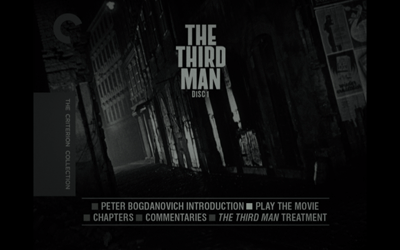
THE DVD
Video:
While the movie itself might be an absolute must, Third Man fans know that this new two-disc version of the movie is a double-dip release for the Criterion Collection. The original single-disc edition was released in 1999, and it's a high watermark in DVD production. Even now, it's still one of the best, with great extras and a gorgeous restoration job done on the film negative.
So, why release it again? Well, when it comes to the picture quality, here lies controversy. The old DVD transfer of The Third Man was a tremendous effort, cleaned and polished frame by frame, with countless instances of dust and scratches being removed. Apparently, the transfer here is yet another clean-up job, and it's just as good, if not better, in the surface image department. Some instances of debris still remain, including a very obvious line down the center of the screen midway through, but one would have to watch both discs side by side to see how different it really is.
Where Criterion have noticeably improved on their old disc is in the overall "feel" of the picture. The new 1.33:1, full-screen transfer isn't as bright, which is good news for a movie that is intended to be dark. Criterion can also now take advantage of many more years of technological advancement, and so there aren't any compression issues or problems with artifacting. In those areas, there is nothing really to complain about.
What will likely have some tongues wagging, however, is Criterion's decision to "picturebox" the frame, something they have been doing on a lot of their DVDs lately. What this means is that my sister, who always complains about the black bars at the top and bottom of her screen, can now complain about them being on the right and left, too. I will attempt to show you how this looks through screengrabs taken on my laptop, and compare them to grabs from the original DVD. (I will get these as close as possible, but keep in mind this is inexact and not science.)
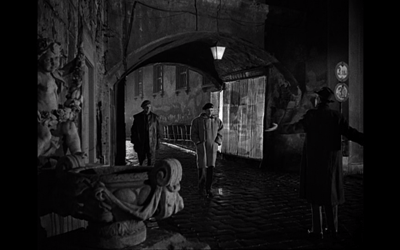
1999
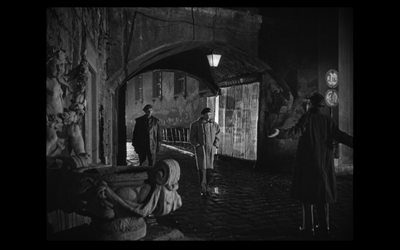
2007
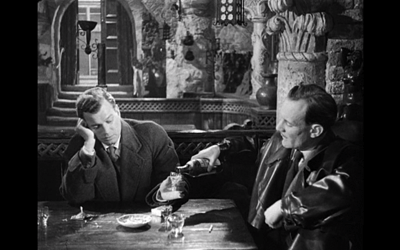
1999
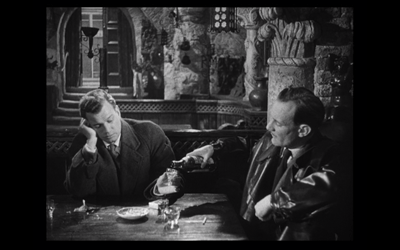
2007
Basically, when The Third Man was transferred in this format, some information might have been lost on either side of the frame. You can see it in the above, most obviously on the left side. Personally, I don't see this as an egregious change, and short of Carol Reed popping up and saying, "No, I intended 100% for that little bit of drinking glass to be seen," it's not really going to bother me all that much. Some may consider me a philistine for this, but compared to the years of abuse through improper framing most films have been subjected to, I don't see pictureboxing as a concentrated attempt to annihilate the image integrity of The Third Man; in fact, quite the contrary, given all the other effort that has been put into making this a splendid DVD set. Criterion may eventually regret these decisions as the various types of widescreen TVs increasingly become the norm, but for now, it's really going to be up to you for how much this bugs you. Decide to upgrade or not to upgrade as you see fit.
Sound:
The mix here is in mono, but it's as cleaned up as the picture. No hiss, no extraneous pops. Very well done.
Extras:
Again, here is an important area where the question of "Why double-dip?" comes into play. The single DVD version of The Third Man already had quite a lot by way of extras, and most of those are all included on this edition (a dropped restoration demonstration is no longer necessary, one gathers). They are as follows:
* Video introduction by Peter Bogdanovich.
* An audio reading of Graham Greene's treatment for The Third Man (which is, in effect, a short novel and well worth seeking out on its own), performed by actor Richard Clarke.
* An episode of the subsequent Harry Lime radio series written by and starring Orson Welles, and the 1951 radio adaptation of The Third Man.
* An alternate voiceover performed for the opening of the film by Joseph Cotten, used on the original U.S. release.
* The trailer for the original U.S. theatrical run (though the trailer for the U.S. re-release is now absent).
* Archival footage of composer Anton Karas playing his Zither in a London club.
* Vintage newsreel footage of the Vienna sewers.
A final holdover extra from the original that is actually improved upon for the new edition is the gallery of production stills and promo material. In 1999, the feature was a scroll-through gallery with text written by Charles Drazin. Now it is an animated gallery, same pictures and text, but the images change on their own and it's narrated by Rob Webb over the top of the snaps, rather than appearing as text on separate title cards. It runs 8 minutes, 45 seconds.
Given that we already know the unchanged extras from the old edition are good, let's skip ahead to what is new, and what will likely inspire you to want to buy The Third Man - Criterion Collection again.
First up is the addition of two full-length audio commentaries on DVD 1. One is a scholarly, critical analysis by Dana Polan. The other, and the real gem, is a conversation between filmmaker Steven Soderbergh (Traffic, The Good German) and screenwriter Tony Gilroy (the Jason Bourne series of films). The two film pros trump Polan for the more fascinating track. It's essentially two guys who love the film discussing it and relating much of what they see to their experience from film productions, puzzling out how things are put together and searching for why it works.
Not that Polan isn't interesting. His discussions of genre particularly fascinate me. It's just a bit more rigid by comparison to the conversational approach.
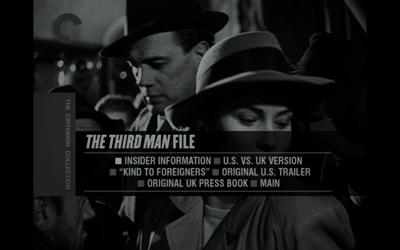
DVD 2 contains nothing but bonus features.
* "Kind to Foreigners," a trio of scenes from the film where characters speak in a language other than English and their dialogue was left untranslated because the audience was meant to be in tandem with Holly Martins, who didn't understand what they were saying. They are subtitled here for the first time. (5:20)
* A gallery of the U.K. pressbook.
* Shadowing "The Third Man", a 2005 documentary that is about as detailed of a dissection of The Third Man as you're likely to get. It uses scenes from the film, new interviews, archival footage from the shoot, and later interviews with participants no longer with us. Much attention is paid to the push-pull of the film's two producers, the British Alexander Korda and American David O. Selznick, who had very different managerial styles. The feature's only flaw is that sometimes the clips go on a little too long, even if they are creatively recontextualized. (93 minutes)
* Who Was the Third Man?, a 2000 documentary from Austria tracking the film's production in their country, looking at the real life parallels and the cultural impact it had. Notable for scenes of the film using the German dub and Austrian newsreel footage of Welles and Reed. Also, we see Herbert Halbik, who played the son of the Porter in the movie, all growed up. So, too, do we see many of the film's locations fifty years on. Though, we also see glimpses of these things in Shadowing, too. Both films share some material/information, it's just the slant of vision they take. (29:10)
* Graham Greene: The Hunted Man, a 1968 episode of the British TV show Omnibus that had the author as its subject. It covers Greene's full career and is extremely insightful and informative. Interestingly, though Greene participated, he only allowed his voice to be recorded, not his image--a philosophical choice he actually explains. (56:23)
* "The Third Man's Vienna" - a photo gallery of the city as it looked after WWII, along with accompanying text explaining what the images are. There are also some great propaganda posters used as part of the explanation of the various workings of the city that Graham Greene put together for his story.
The interior booklet this time around is much thicker and nicely printed on glossy paper. Michael Wilmington's liner notes from 1999 are dropped, but we get three new pieces in its stead--ruminations on the film by Luc Sante and Charles Drazin and an article on Graham Greene by Philip Kerr. We also get many excellent full-page stills from the movie. The box for The Third Man - Criterion Collection is just as nicely printed, featuring thematically linked photos on a hardy cardboard, double-tray gatefold, as well as an outer slipcase.
FINAL THOUGHTS:
Sometimes a cliché is a cliché because it's true, and sometimes a movie is a classic because it's that good. The Third Man is just such a movie, a knotty post-War thriller, a sort of Hitchcock noir. It made a fad out of the zither and gave Orson Welles one of his most famous personas. Now, the Criterion collection gives The Third Man the kind of extensive examination it deserves. Their second edition of this most-respected of movies spans two discs, leaving no stone unturned in the pursuit of the real secrets that dot the spine of Graham Greene and Carol Reed's most successful collaboration. For all of that, The Third Man - Criterion Collection is part of the DVD Talk Collector Series.
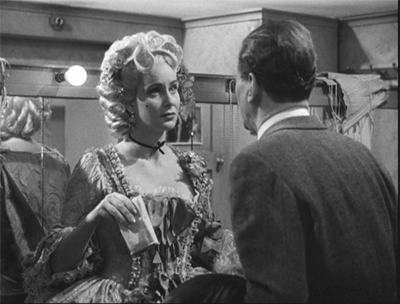
Jamie S. Rich is a novelist and comic book writer. He is best known for his collaborations with Joelle Jones, including the hardboiled crime comic book You Have Killed Me, the challenging romance 12 Reasons Why I Love Her, and the 2007 prose novel Have You Seen the Horizon Lately?, for which Jones did the cover. All three were published by Oni Press. His most recent projects include the futuristic romance A Boy and a Girl with Natalie Nourigat; Archer Coe and the Thousand Natural Shocks, a loopy crime tale drawn by Dan Christensen; and the horror miniseries Madame Frankenstein, a collaboration with Megan Levens. Follow Rich's blog at Confessions123.com.
|
| Popular Reviews |
| Sponsored Links |
|
|
| Sponsored Links |
|
|
| Release List | Reviews | Shop | Newsletter | Forum | DVD Giveaways | Blu-Ray | Advertise |
|
Copyright 2024 DVDTalk.com All Rights Reserved. Legal Info, Privacy Policy, Terms of Use,
Manage Preferences,
Your Privacy Choices | |||||||









